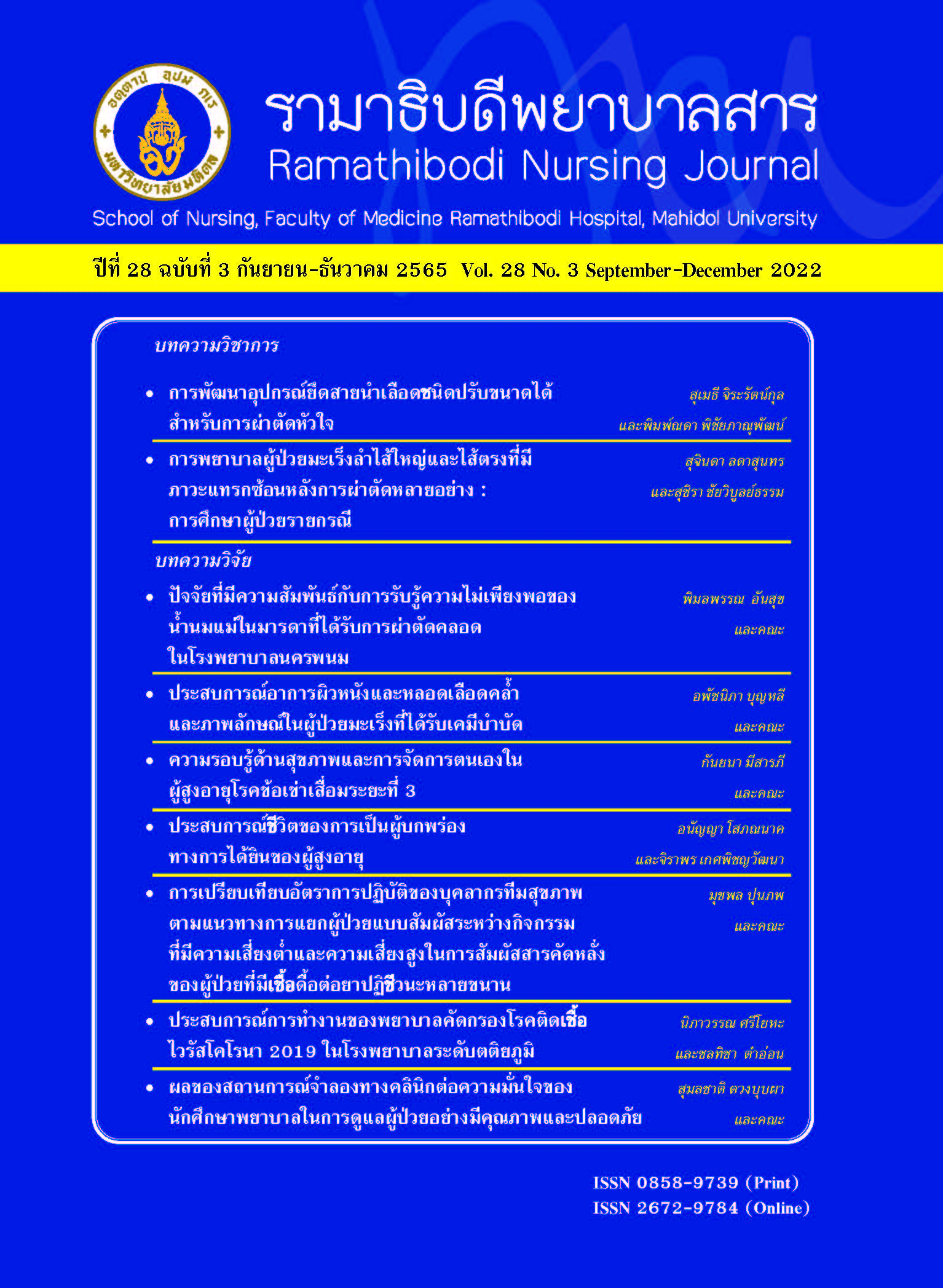The Effect of Clinical Simulation on Nursing Students' Self-confidence to Provide Quality and Safety of Patient Care
Main Article Content
Abstract
This quasi-experimental study used one group pretest-posttest design. The Quality and Safety Education for Nurses—QSEN principles were used as a conceptual framework to study. The purposes were to 1) explore nursing students’ quality and safe nursing care practice while participating in clinical simulations, 2) compare nursing students' scores of self-confidence in quality and safe nursing care practice before and after participating in a clinical simulation, and 3) describe nursing students’ perceived learning promotion through clinical simulations. A purposive sample of 54 thirdyear nursing students who practiced in an adult and elderly nursing practicum course was recruited.Three simulation scenarios were set up. The instruments for collecting data included the Personal Data Questionnaire, the Nursing Practice Assessment Form, the Self-confidence in Practicing Quality and Safe Nursing Care, and the Learning Promotion by Clinical Simulations Assessment Form. Data were analyzed using descriptive statistics and paired t-test. The results are as follows. Firstly, nursing students practiced nursing care of patients in all three simulation scenarios correctly at 100 % on the topic of teamwork and cooperation; they practiced nursing care of patients correctly at 50-66.67 % on the evidence-based practice and quality improvement topic. Secondly, the mean self-confidence score for practicing quality and safe nursing care of the nursing students after the simulation period was significantly higher than that before the simulation period. Lastly, teaching with simulations promoted nursing students’ learning at a high level. The top three teaching activities that promoted learning with high average scores included reflection, participation in the simulation, and being an observer. In conclusion, this study reflects the effect of clinical simulation teaching on nursing students' confidence in performing quality and safe nursing care. Therefore, teachers could use clinical simulations-based learning to provide nursing students with patient care experiences and promote awareness of quality and safe patient care prior to clinical practice.
Keywords: Clinical simulation, Self-confidence, Nursing students, Patient Care, Quality, Safety
Article Details

This work is licensed under a Creative Commons Attribution-NonCommercial-NoDerivatives 4.0 International License.
บทความ ข้อมูล เนื้อหา รูปภาพ ฯลฯ ที่ได้รับการตีพิมพ์ในรามาธิบดีพยาบาลสาร ถือเป็นลิขสิทธิ์ของวารสาร หากบุคคลหรือหน่วยงานใดต้องการนำทั้งหมดหรือส่วนหนึ่งส่วนใดไปเผยแพร่หรือเพื่อกระทำการใด ใด จะต้องได้รับอนุญาตเป็นลายลักษณ์อักษรจากรามาธิบดีพยาบาลสารก่อนเท่านั้น
References
World Health Organization. 10 facts on patient safety [Internet]. WHO;2019 [cited 2022 May 15]. Available from: https://www.who.int/news-room/photo-story/photo-story-detail/10-facts-on-patient-safety
Healthcare Accreditation Institute (Public Organization).Strategies for patient and personnel safety (2P safety):phase 4 (2018-2021). Nonthaburi: Healthcare Accreditation Institute (Public Organisation); 2017 [cited2022 May 15]. Available from: https://www. sem100library.in.th/opac/Catalog/AddLinkHistory.asp x?bibID=b00015085&link=http://www.sem100 library.in.th/medias/b15085.pdf&type=1
Ramathibodi School of Nursing, Faculty of Medicine Ramathibodi. Programme specification of bachelor of nursing program (revised curriculum for the academic year 2017-21). Bangkok: Ramathibodi School of Nursing;2017 [cited 2022 May 10]. Available from: https://
www.rama.mahidol.ac.th/education/th/undergrad_programs (in Thai)
Sherwood G, Zomorodi M. A new mindset for quality and safety: the QSEN competencies redefine nurses’ roles in practice. Nephrol Nurs J. 2014;41(1):15-22.
Jerayingmongkol P, Naksrisang W, Nahathaiphokin J,Hirunkhro B, Triudomsri S. Causes of incidents on the wards of nursing students. EAU Heritage Journal Science and Technology. 2021;15(2):220-30. (in Thai)
Kiessling A, Amiri C, Arhammar J, Lundbäck M,Wallingstam C, Wikner J, et al. Interprofessional simulation-based team-training and self-efficacy in emergency medicine situations. J Interprof Care. 2022;36(6):873-81. doi: 10.1080/13561820.2022.203 8103.
El Hussein MT, Harvey G, Bell N. The influence of nursing simulation on patient outcomes and patient safety: a scoping review. Clin Simul Nurs. 2022;70:37-46. doi:https://doi.org/10.1016/j.ecns.2022.06.004.
Jeffries PR, Rodgers B, Adamson K. NLN Jeffries simulation theory: brief narrative description. Nurs Educ Perspect. 2015;36(15):292-3. doi: 10.5480/1536-5026-36.5.292.
Cordeau MA. Teaching holistic nursing using clinical simulation: a pedagogical essay. J Nurs Educ Pract.2013;3(4):40-50. doi: 10.5430/jnep.v3n4p40.
Healthcare Accreditation Institute (Public Organization).WHO patient safety curriculum guide: multidisciplinary edition (Thai version). Vol.2. Nonthaburi: Healthcare Accreditation Institute (Public Organisation); 2015.
Kolb AY, Kolb DA. Learning styles and learning spaces:enhancing experience learning in higher education. Acad Manage Learn Educ [internet]. 2005 [cited 2022 Mar3];4(2):193-213. Available from: https://www.jstor.org/stable/40214287?seq=2
World Health Organization. Patient safety curriculum guide: multi-professional edition. [Cited July 2017.]Available from: http://www.who.int/patientsafety/education/curriculum/en
Iskander M. Systematic review and meta-analysis of computer based simulation training for non-technical skills training and knowledge in postgraduate medical education.J Med Educ. 2019;18(1):38-49. doi: 10.22037/jme.v18i1.23724.
Hussein ME, Harvey G, Kilfoil L. Pre-brief in simulationbased experiences: a scoping review of the literature. Clin Simul Nurs [internet]. 2021 [cited 2022 Mar 12];61:86-95. Available from: https://www.sciencedirect.com/science/article/pii/S1876139921000906
Suwannakeeree W, Jullmusi O, Inkaew T, Tangkawanich T, Rueangram S. Satisfaction and self-confidence in critical care nursing of nursing students learning with simulation-based learning. Journal of Nursing and Health Sciences. 2017;11(3):167-77. (in Thai)
Lee SJ, Johnson W, Liddell T. Quality improvement for self-confidence, critical-thinking, and psychomotor skills in basic life support of nursing health professionals through case-scenario simulation training. J Nurs Educ Pract.2021;11(8):23-31. doi:10.5430/jnep.v11n8p23.
Oh H. Effects of simulation learning using SBAR on clinical judgment and communication skills in undergraduate nursing students. International Journal of Contents [internet]. 2021 [cited 2022 Mar 12];17(3):30-37. Available from: chrome extension://efaidnbmnnnibpc
ajpcglclefindmkaj/http://koreascience.or.kr/article/JAKO202128640548164.pdf
Sakcharoen P. Adult learning theory and self-directed learning concept: learning process for promoting lifelong learning. Journal of The Royal Thai Army Nurses.2015;6(1):8-13. (in Thai)
Pattaragorranan N. Concepts and management techniques of adult learning. Journal of Education, Silpakorn
University [internet]. 2014 [cited 2022 Mar12];12(1,2):18-29. Available from: https://so02.tci thaijo.org/index.php/suedujournal/article/view/94934/74182 (in Thai)
Alshutwi S, Alsharif F, Shibily F, Wedad MA, Almotairy MM, Algabbashi M. Maintaining clinical training continuity during COVID-19 pandemic: nursing students’ perceptions about simulation-based learning. Int J Environ Res Public Health. 2022;19(4):2180. doi: 10.3390/ijerph19042180.
Wright HH, Cameron J, Wiesmayr-Freeman T, Swanepoel L. Perceived benefits of a standardized patient simulation in pre-placement dietetic students [internet]. Educ Sci.2020;10(7):186. doi: 10.3390/educsci10070186.


